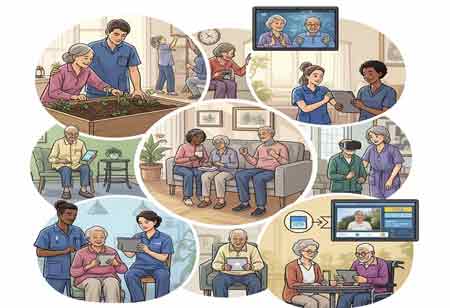Thank you for Subscribing to Eldercare Review Weekly Brief
Whole-Person Wellness at Home: Redefining the Care Experience
The in-home care services sector is experiencing rapid growth, driven by an aging population, technological advancements, and a shift toward personalized, holistic care models within home settings.

By
Eldercare Review | Thursday, July 10, 2025
Stay ahead of the industry with exclusive feature stories on the top companies, expert insights and the latest news delivered straight to your inbox. Subscribe today.
The in-home care assistance services sector stands as a pivotal and rapidly expanding segment of the broader healthcare industry. Driven by profound demographic shifts, technological advancements, and evolving consumer preferences, this sector is undergoing a transformative period, moving towards more personalized, efficient, and integrated models of care delivery. The fundamental appeal of receiving care within the familiar confines of one's home continues to fuel its growth and innovation.
A Growing Imperative: Demographics and Demand
At the heart of the burgeoning in-home care market is the inexorable demographic trend of an aging global population. As life expectancies increase, a larger proportion of individuals are living into their senior years, many of whom prefer to "age in place" – remaining in their homes as long as possible. This strong consumer preference is a primary catalyst for demand. Furthermore, the rising prevalence of chronic conditions such as heart disease, diabetes, and various forms of dementia among older adults necessitates ongoing, often complex, care that can be effectively delivered within a home setting. The desire for independence and comfort, coupled with the recognition that home-based care can frequently be a more desirable alternative to institutional living, collectively drives a significant and sustained demand for these services.
The scope of in-home care has expanded significantly beyond rudimentary personal assistance. Modern in-home care models are increasingly holistic, encompassing a broad spectrum of services designed to address the comprehensive physical, emotional, and social needs of individuals. This includes assistance with daily living activities (ADLs), medication management, skilled nursing care, physical and occupational therapies, as well as specialized support for complex medical conditions. There is a growing emphasis on personalized care plans, meticulously crafted to meet the unique requirements and preferences of each individual, fostering a greater sense of autonomy for the care recipient and promoting better outcomes.
Technological Integration: Enhancing Efficiency and Efficacy
Technology is undeniably reshaping the delivery and effectiveness of in-home care services. The integration of smart home devices, wearable health monitors, and telehealth platforms is changing the way care is provided and managed, enhancing both efficiency and efficacy. Remote monitoring tools enable real-time tracking of vital signs and health analytics, allowing for proactive interventions and reducing the need for frequent in-person visits. This not only enhances patient safety but also offers peace of mind to families and caregivers.
Telehealth, which experienced a significant surge during the recent global health crisis, remains a preferred option for remote consultations, follow-ups, and even some diagnostic assessments. Artificial intelligence (AI) and data analytics are being leveraged to analyze vast amounts of patient data, identifying health trends, predicting potential issues, and assisting in the development of more personalized care plans. For caregivers, technology streamlines administrative tasks, improves communication through care coordination apps, and ensures compliance with electronic visit verification (EVV) systems. User-friendly design principles are paramount in the development of these technologies, guaranteeing accessibility for older adults who may not be highly tech-savvy. One innovative approach that is gaining traction is the 'Hospital at Home' model, facilitated by technological advancements and favorable reimbursement policies. This model enables patients to receive acute, inpatient-level care in the comfort of their own homes, thereby reducing the need for hospital stays and promoting patient comfort and recovery.
Workforce Dynamics: Professionalization and Support
The in-home care sector relies heavily on a dedicated and skilled workforce. The ongoing demand necessitates robust strategies for the recruitment and retention of caregivers. The professionalization of caregiving is a prominent trend, with an increasing focus on specialized training programs, certifications, and continuous education to equip caregivers with the expertise needed to manage complex health needs. Efforts are being made to enhance the caregiver experience through comprehensive support systems, including mental health resources, flexible scheduling options, and recognition programs. Technology plays a crucial role in supporting the workforce by automating repetitive tasks, improving internal efficiencies, and freeing up caregivers to focus more on direct patient interaction. Public-private partnerships are also emerging to foster a homegrown workforce, demonstrating a collaborative approach to addressing the sector's staffing requirements.
The economic impact of in-home care assistance services is substantial and continues to grow. From a macro perspective, increased investment in home support can alleviate pressure on hospitals and residential care facilities, contributing to the overall healthcare system. Studies indicate that home health care can be a more cost-effective option than institutional care, resulting in significant savings in long-term healthcare expenditures. This cost-efficiency is a considerable factor driving policy decisions and reimbursement models.
The regulatory environment governing in-home care services is intricate and continually evolving. Compliance with state and federal standards is critical, encompassing areas such as accurate documentation, proper billing and reimbursement procedures, caregiver training and certification, and stringent privacy and security measures, particularly related to patient health information. Regulatory bodies are increasingly emphasizing the accuracy and transparency of data, ensuring accountability and the quality of care. The shift towards value-based care models is also influencing how agencies operate and measure success, tying reimbursement to patient outcomes and quality metrics.
The trajectory of in-home care assistance services points towards an increasingly integrated, technology-driven, and profoundly person-centered future. The desire for independence, coupled with advancements in care delivery and a supportive economic and regulatory environment, ensures that this sector will remain a vital component of the healthcare ecosystem. The ongoing evolution will prioritize holistic well-being, leveraging innovative solutions to provide high-quality, compassionate care that empowers individuals to live fulfilling lives within their chosen environments.






